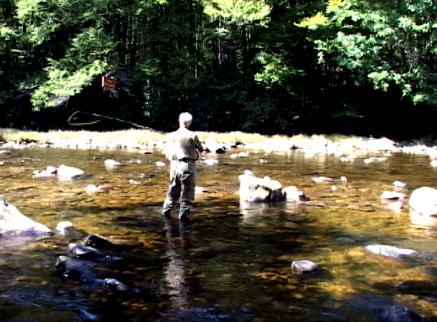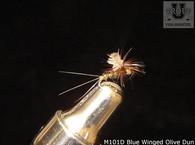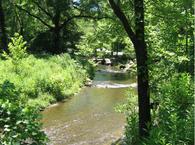
The Cranberry River is formed by the confluence of its North and South forks. The South Fork rises on Cranberry Mountain just west of the Highland Scenic Highway, and flows 9 miles including going through the Cranberry Glades Botanical Area before meeting the North Fork which originates on Black Mountain. After the confluence, the Cranberry River flows 24 miles generally westward to join the Gauley River near Craigsville. It flows through the huge 35,864-acre Monongahela National Forest wilderness area along the way. The Cranberry River holds more trout per acre than any other stream in West Virginia.
The Cranberry River consists of two sections, the lower end and the back country. The backcountry includes 16 miles of remote stream including the North Fork and the South Fork branches. No vehicles, except bicycles, are allowed in the back country area. Excellent access is available to the lower section of the river which has roads that runs near the stream the entire distance. A great deal of the Cranberry River flows through the United States Forest Service land providing easy access as well.
The excellent trout fishing available on the Cranberry is due primarily to the addition of limestone and the fine care given to it by the WVDNR. Limestone drums treat many miles of the river to ensure that the pH level provides a great habitat for aquatic insects which in turn support the healthy population of trout.
The backcountry section including the North and South Forks as well as the Dogway Fork which has a six mile stretch designated "Fly Fishing Only". Contain mostly brook trout. The gradient of the river is quite steep in the area of the canyon containing plunging pools and pocket water but the river remains wade able. The stream is small and overhung by laurel and rhododendron. The lower section is wider and contains long gravel bottomed runs and riffles.
Spring:
Spring is obviously the best time to fish the Cranberry with the healthy eastern green drake hatch starting in late May and June.
Summer:
The fishing remains good in the summer due to the overhanging rhododendrons that provide shade for the stream. The light cahills will be hatching in June and July.
Fall:
The fall of the year is a good time to be on the river and the terrestrials will work for you. Be cautious in September if the river is low creating a stressful environment for the trout.
A word of caution when fishing some of the WVA streams. Didymo has been found in Seneca and other streams indeed be careful not to spread it.
There is parking at the Cranberry Glades trailhead and also along Forest Road 76; and there is an abandoned railroad right of way that follows the river. Few people live along the entire length but there are numerous campsites and hiking shelter available to use.
Hatches N/A
View Northeast USA in a larger map





